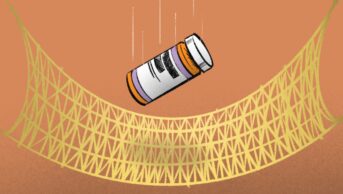Pharmacists’ contribution to patient care and safety while authorising (clinically checking) discharge prescriptions was audited at the Royal Liverpool University Hospital (RLUH).
Method
Over one week, all electronically generated discharge prescriptions received during normal working hours at the RLUH were audited. Doctors generate an “unauthorised” prescription by transcription from the handwritten inpatient chart, and this was compared with the final pharmacist-authorised copy. Data collected included the ward, item count, grade of pharmacist authorising the prescription and where it was authorised (at ward level or in the dispensary). Any pharmacist amendments were recorded and graded by the investigator and senior pharmacists in a way that closely matched the trust’s clinical incident reporting system: minor significance (no effect on outcome); moderate significance (potentially undesirable); major significance (potentially detrimental for patient outcomes).
Key points
- Over half of discharge prescriptions required alteration by pharmacists
- Pharmacists are essential to the safe discharge of patients from hospital
Results
A total of 387 discharge prescriptions were received in the pharmacy. Over half (56.1 per cent) had had a change made by a pharmacist, affecting 504 (15.2 per cent) of 3,106 items, (mean 1.3 amendments per discharge prescription). The nature of the amendments made is shown in Table 1; about a fifth (20.7 per cent) of prescriptions had an intervention in the category “major severity”. Although there was variation between wards, there was no difference in the amendment rate or in the severity score between junior and senior pharmacists. There was a statistically significant difference (P=0.017) in amendment rates (1.37 v 1.00) between prescriptions that had been authorised on the ward and the minority of unauthorised ones that had to be dealt with in the pharmacy.

Discussion
The changes identify the contribution of pharmacists as inpatient charts are converted by junior doctors to discharge prescriptions. Previous studies[1],[2],[3],[4] differ and are hard to compare with each other or to our results because the following are not always clear:
- The nature of the hospital/wards involved
- Where the prescription is generated and verified, and by whom
- Whether the prescriptions were handwritten or electronically generated
- If the inpatient chart is itself electronically generated, how transcription occurs
- How errors, interventions, and their clinical significance are categorised
- Whether the authorising pharmacist was judged to have spotted all the required interventions
Not all changes to a discharge prescription derive from transcription errors by medical staff. For example, 105 items were added to discharge prescriptions, and these additions may have resulted from pharmacists querying items that had been omitted since admission but possibly required restarting, items normally prescribed in that condition or additional problems identified.
Opportunities to improve the quality of the discharge process The grade of pharmacist was not shown to affect the number or severity score of amendments, but the location of authorisation mattered. All pharmacists at the RLUH share the duty dispensary pharmacist role but, when authorising in the dispensary, are unfamiliar with the details of patients and their admission, are unable to discuss issues directly with patients, and have access to less information. Some hospitals use “discharge pharmacists” to avoid having to send charts and unauthorised prescriptions to a central pharmacy but this cannot be assumed to close the gap seen in our study.
Pharmacists have been shown in controlled studies to prepare prescriptions requiring fewer interventions than doctors, although this does not mean that pharmacist prescribers in uncontrolled practice would be error-free. As in many trusts, pharmacist prescribers at the RLUH do not prepare discharge prescriptions because of time constraints, problems in adding the associated details of the clinical course of the patient, and the need for a second pharmacist to check their work. The model that “doctors prescribe, pharmacists check” seems unchallengeable without further investment in pharmacist hours.
Much work is needed to confirm whether electronic prescribing and medicines administration systems reduce the scale of pharmacist intervention required at discharge. Even if these can reduce transcription errors, it is clear that many of the interventions that pharmacists make at discharge will still be needed. We showed that pharmacists are essential to the safe discharge of patients from hospital, and this will continue as throughput rises, bed stays shorten, and shift patterns mean that discharge prescriptions are increasingly prepared by doctors unfamiliar with the patient.
About the authors
David Larkin, MPharm, was at the time of writing, a preregistration trainee pharmacist at the RLUH, where John Sexton, MSc, MRPharmS, is principal pharmacist-lecturer practitioner (email j.sexton@ljmu.ac.uk).
References
[1] Dean B, Schachter M, Vincent C et al. Quality and Safety in Health Care 2002;11:340–4.
[2] Perren A, Previsdomini M, Cerutti B et al. Omitted and unjustified medications in the discharge summary. Quality and Safety in Health Care 2009;18:205–8.
[3] Gujral S, Wong A. Pharmacy discharge prescription writing: is this the way forward. Clinical Pharmacist 2010;2(Suppl 1):S15.
[4] Rahman M, Green CF, Armstrong DJ. An evaluation of pharmacist-written hospital discharge prescriptions on general surgical wards. International Journal of Pharmacy Practice 2005;13:179–85.


